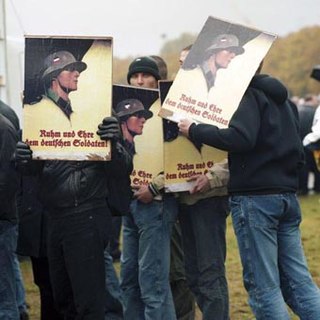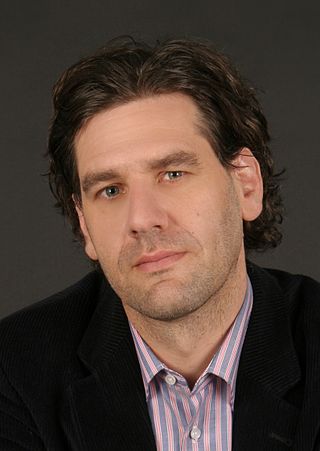
The Commissar Order was an order issued by the German High Command (OKW) on 6 June 1941 before Operation Barbarossa. Its official name was Guidelines for the Treatment of Political Commissars. It instructed the Wehrmacht that any Soviet political commissar identified among captured troops be summarily executed as a purported enforcer of the so-called Judeo-Bolshevism ideology in military forces. It is one of a series of criminal orders issued by the leadership.

During World War II, the German Wehrmacht committed systematic war crimes, including massacres, mass rape, looting, the exploitation of forced labor, the murder of three million Soviet prisoners of war, and participated in the extermination of Jews. While the Nazi Party's own SS forces was the organization most responsible for the genocidal killing of the Holocaust, the regular armed forces of the Wehrmacht committed many war crimes of their own, particularly on the Eastern Front.

The Wehrmacht exhibition was a series of two exhibitions focusing on the war crimes of the Wehrmacht during World War II. The exhibitions were instrumental in furthering the understanding of the myth of the clean Wehrmacht in Germany. Both exhibitions were produced by the Hamburg Institute for Social Research; the first under the title "War of Annihilation. Crimes of the Wehrmacht 1941 to 1944", which opened in Hamburg on 5 March 1995 and travelled to 33 German and Austrian cities. It was the subject of a terrorist attack but the organizers nonetheless claimed it had been attended by 800,000 visitors. The second exhibition – which was first shown in Berlin in November 2001 – attempted to dissipate considerable controversy generated by the first exhibition according to the Institute.
Hans Christian Gerlach is professor of Modern History at the University of Bern. Gerlach is also Associate Editor of the Journal of Genocide Research and author of multiple books dealing with the Hunger Plan, the Holocaust, and genocide.

Jochen Böhlerlisten is a German historian, specializing in the history of Eastern Europe in the 19th and 20th century, especially the World Wars, the Holocaust, nationality and borderland studies. He is the recipient of several international awards. and known to a larger audience due to frequent appearances in TV productions and articles in national newspapers such as, for example, Frankfurter Allgemeine Zeitung or DIE ZEIT. His main thesis on the beginning of WWII and the end of WWI in Eastern Europe has been discussed vividly in German, English, and Polish academic circles.

Harald von Hirschfeld was a general in the Wehrmacht of Nazi Germany who commanded the 78. Volksgrenadier-Division during World War II. He was a recipient of the Knight's Cross of the Iron Cross with Oak Leaves.
Hans-Heinrich Sixt von Armin was a German general during World War II who commanded several divisions. He was a recipient of the Knight's Cross of the Iron Cross. Armin surrendered following the Battle of Stalingrad in 1943 and died in Soviet captivity on 1 April 1952. He was the son of World War I general Friedrich Bertram Sixt von Armin.
The Hamburg Institute for Social Research is an independent private foundation whose scholarship is focused on both contemporary history and the social sciences. Founded in 1984 by Jan Philipp Reemtsma, it currently employs about 50 people with roughly 50% working in the research fields of sociology and history. The institute publishes a bimonthly journal called Mittelweg 36 and has its own publishing house.

Jan Philipp Fürchtegott Reemtsma is a German literary scholar, author, and patron who founded and was the long-term director of the Hamburg Institute for Social Research. Reemtsma lives and works mainly in Hamburg.
Walter Braemer was a general in the Reichswehr and the Wehrmacht and a high-ranking SS commander during the Nazi era. He was a Nazi criminal responsible for mass murders of the civilian population of Bromberg/Bydgoszcz in Poland at the outset of the Second World War, and later for crimes against humanity in the Holocaust in the Soviet Union. He escaped prosecution and punishment after the war despite having been held for 2+1⁄2 years as a prisoner of war by the British.
The Hamburger Edition is the publishing house of the Hamburg Institute for Social Research. It was established in the fall of 1994 with the aim of publishing results of the Institute's scholarship with the broader public in mind. In its over 20-year history, the Hamburger Edition published monographs, essays, and books by more than five hundred authors, many of whom served as members of the Institute while others came from a range of related disciplines in the German-speaking world, and internationally.

The myth of the clean Wehrmacht is the negationist notion that the regular German armed forces were not involved in the Holocaust or other war crimes during World War II. The myth, heavily promoted by German authors and military personnel after World War II, completely denies the culpability of the German military command in the planning and perpetration of war crimes. Even where the perpetration of war crimes and the waging of an extermination campaign, particularly in the Soviet Union – where the Nazis viewed the population as "sub-humans" ruled by "Jewish Bolshevik" conspirators – has been acknowledged, they are ascribed to the "Party soldiers corps", the Schutzstaffel (SS), but not the regular German military.
Felix Römer is a German historian who specialises in the history of World War II. He has conducted pioneering research into the implementation of the Commissar Order by combat formations of the Wehrmacht and the attitudes of German soldiers based on the surreptitiously recorded conversations of prisoners of war held in Fort Hunt, Virginia, United States.
The 285th Security Division was a rear-security division in the Wehrmacht of Nazi Germany. The unit was deployed in German-occupied areas of the Soviet Union, in the Army Group North Rear Area.
Klaus Naumann is a German historian and author who specialises in modern European history. His research and writings have focused on contemporary interpretations of the legacy of World War II and on cultural history. Naumann authored several books on these topics, published both in German and in English.
A war of annihilation or war of extermination is a type of war in which the goal is the complete annihilation of a state, a people or an ethnic minority through genocide or through the destruction of their livelihood. The goal can be outward-directed or inward, against elements of one's own population. The goal is not like other types of warfare, the recognition of limited political goals, such as recognition of a legal status, control of disputed territory, or the total military defeat of an enemy state.
Heinz Magenheimer is an Austrian military historian known for advancing the now discredited theory of a preemptive strike by the Wehrmacht against the Soviet Union.
Ulrike Jureit is a German historian.

Walter Stettner Ritter von Grabenhofen was a German general in the Wehrmacht during World War II and a recipient of the Knight's Cross of the Iron Cross. In October 1944 he went missing in action on Mount Avala, near Belgrade in Serbia.
Korück is an abbreviation for Army Rear Area Commander. It referred also to the staff of various units and of varying sizes assigned to the Wehrmacht's Armeeoberkommando. In military jargon, “Korück” did not only stand for the corresponding agency but usually also for the entire rear army area, which was subordinate to this agency, often also for the entire military unit of this agency.







